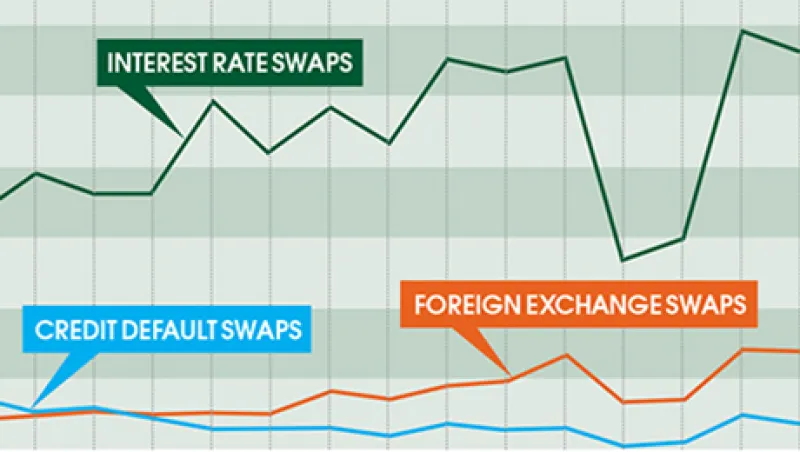On February 17 the U.S. swaps market entered a new era. That’s when it became mandatory to trade the first of certain categories of the complex derivatives, used by financial institutions to hedge risk, on swap execution facilities (SEFs), the transparent electronic trading venues whose creation was a key component of overhauling the markets after the 2008–'09 financial crisis. But even as the Commodity Futures Trading Commission, which oversees swaps regulation in the U.S., has approved the most common varieties of swaps for mandatory trading on SEFs, it remains unclear how the seismic shifts in the market will affect users of swaps and the institutions that manage execution.
The CFTC has approved the registration of 21 SEFs since applications opened in mid-2013. Most have been executing and reporting trades since October 2, when SEF trading went live. Volumes have since risen rapidly: In interest rate swaps, which account for more than three quarters of the U.S. swaps market, weekly trading had increased to almost $2 trillion in early February, from $518 billion in early October. This rebuts, if provisionally, the widespread fear that swap futures — the hybrid, futurized versions of swaps that several exchanges introduced in late 2012 to capitalize on marketwide confusion over reform — would render the swaps market irrelevant. Activity in deliverable swap futures, a product of this type offered by Chicago-based CME Group, has remained robust even as SEF trading has grown.
But try to get a sense of which SEFs are emerging as winners and losers and the picture grows murkier. “The one thing we can say for sure is that Bloomberg is dominating more than ever,” says Tod Skarecky of Clarus Financial Technology, a Chicago-based advisory firm that tracks the SEF universe. Data giant Bloomberg’s SEF has enjoyed spectacular early success in credit default swaps, rapidly establishing itself as a market leader in the dealer-to-client market segment, in which SEFs interact directly with the buy side.
But the bulk of the swaps market operates on a dealer-to-dealer model, whereby dealers, usually large banks transacting on behalf of buy-side clients, seek price discovery from one other via interdealer brokers. The IDBs won an important victory early last year when they persuaded the CFTC to allow voice execution on SEFs, enabling them to preserve the core of their existing execution model; Clarus’s data, which comes from the SEFs themselves, supports the view that IDBs will keep attracting healthy volumes in swaps trading.
But brokers will have to adapt as more kinds of swaps are mandated for trading on SEFs, according to Skarecky. Whereas previously brokers were free to seek prices from dealers informally, based on a highly personalized sense for where the market was, “now they will have to look into an order book — a registered, logged, electronic order book — or request a quote from at least two different names,” Skarecky explains. “It’s a completely different mind-set and approach.”
Many see the success of Bloomberg’s SEF as a vivid illustration of the strength of its terminal; clients already pay $20,000 a year for a terminal subscription, so it can charge exceptionally low transaction fees, around $10 a trade, on its SEF. IDBs charge commissions that reach thousands of dollars per trade, as the average size of trades in the dealer-to-dealer world is far larger than with dealer-to-client. “Expensive SEFs are going to have to cut their charges,” predicts Jodi Burns, New York–based head of regulation at media and data conglomerate Thomson Reuters, which operates a foreign-exchange-focused SEF.
This is part of a wider trend that will see trade sizes fall and the profitability of execution compress, says Will Rhode, head of fixed-income research at advisory firm Tabb Group in New York. Many IDBs are wondering if the shift to an electronic marketplace will make it unfeasible to stay in business. “Operating a SEF is a costly endeavor, and the industry is working very hard to demonstrate that these businesses can be profitable,” acknowledges Christopher Ferreri, head of e-commerce Americas at London-based ICAP, the world’s largest IDB.
But the news isn’t all gloomy for IDBs. Rhode points out that 70 percent of the 700 or so institutions that trade swaps in the U.S. do so by phone; although the Bloomberg terminal is a valuable Trojan horse, it arguably restricts the company’s access to clients that have no existing terminal infrastructure and are already comfortable with voice execution. And IDBs will now be able to seek business directly from the buy side, whereas previously they interacted with the sell side only — a change that may not just annoy the dealer community but “disintermediate it altogether,” according to Rhode.
The months ahead promise to be interesting. • •







